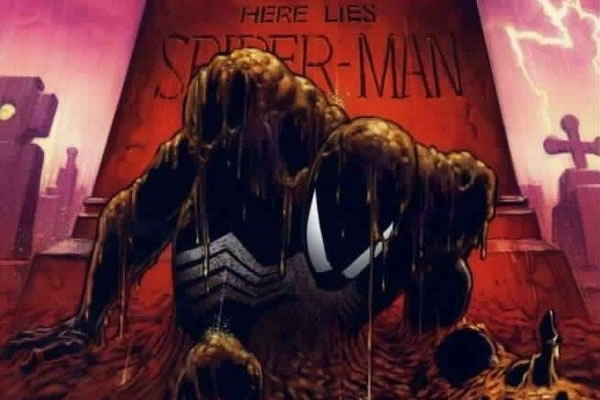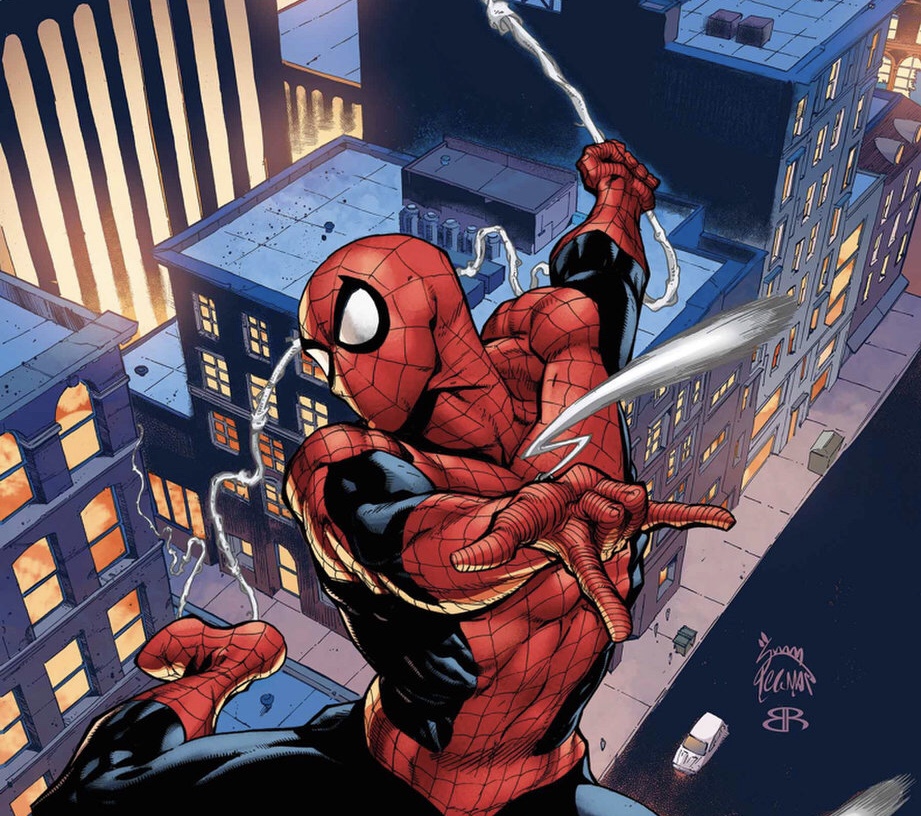
This year’s East Coast Comicon in Seatuaket, New Jersey featured a panel celebrating the 30th anniversary of Kraven’s Last Hunt. It was moderated by Brandon Montclare, writer of Moon Girl & Devil Dinosaur. In attendance were the creative team of the story: writer J.M. DeMatteis, penciler Mike Zeck, inker Bob McLeod, letterer Rick Parker and editor Jim Salicrup. There had been a similar panel at the con for the 30th anniversary of the bwahaha era of the Justice League, so this was a busy convention for DeMatteis. He noted that this was probably the first time the entire group had been in the same room together all at once.
Montclare’s first question was whether the story was a response in any way to Watchmen & The Dark Knight Returns, two DC Comics stories that came out in 1986 and were immediately copied by the rest of the industry. DeMatteis said that it had nothing to do with that. The germ of the idea started as a Wonder Man story, because he had heard that Wonder Man could come back from the dead, and thought it would be interesting to see what happens when the Grim Reaper buries Wonder Man for an year. This pitch was rejected. He went to DC pitching a graphic novel in which the Joker does something similar to Batman. This was also rejected, as was a follow-up pitch with Hugo Strange taking over as the villain. Jim Salicrup offered him Spectacular Spider-Man, and he thought about using the idea for Spider-Man. It was originally going to feature a new villain. However, at the Marvel offices, he was flipping through an issue of Official Handbook to the Marvel Universe and read in the entry for Kraven the Hunter that the villain was Russian. For all he knows, this was a throwaway line that hadn’t been featured in any of the comics, but as a fan of Dostoevsky, he thought Russian roots were something that can be explored in the story. He also used Vermin when he learned that he would be reuniting with his Captain America collaborator Mike Zeck, since the man-rat had been a villain in that series. DeMatteis remarked that he had gotten divorced around the time he wrote the story so all of that personal angst made it into the comic.
DeMatteis believed that Peter and MJ had just gotten married when he pitched the story. Salicrup said that the pitch was approved just before that, remembering when Jim Shooter (Editor in Chief of Marvel at the time) came up to him to talk about how Stan Lee had made some comments in a convention about how Spider-Man and Mary Jane might get married, and what does he think of that. Salicrup thought it would be a good way to shake up the series, and figured that the marriage might be a ways off given that Peter and Mary Jane weren’t even dating yet in the comics., and this would let them get some will they/ won’t they tension in the series, something popular in TV shows at the time (Cheers, Moonlighting, etc.) However, the marriage ended up happening a lot faster than they thought.

DeMatteis thought it ended up being important for the comics that Peter had just gotten married, because it explained why Peter fought so hard. He said in a mock-indignant manner, “They were living in the apartment and carrying on in there so I hope they were married.” He checked Montclare’s copy of the trade paperback to confirm that the characters were married in the comics. An interesting factoid was that the apartment Peter and MJ lived in was based on Rick Parker’s apartment. He laughed about how Peter and MJ were messy guests.
Salicrup credited Mike Zeck’s storytelling abilities, especially his layouts and design. He wondered how the Comics Code accepted the story given the violence and the male nudity, which DeMatteis joked was the reason the story was so popular. Mike Zeck recalled that only one thing was changed due to concerns about content. In a scene in which Vermin was surrounded by the bones of his victims; Zeck was asked to remove a few of the bones.
DeMatteis said that there were some accidents that made the story more successful. It helped that Peter had just got married. It also worked better to have the story set at the time Spider-Man had the black costume, because it would have looked silly to have Kraven impersonating him in the red and blue, but that the black costume fit the tone so well.

Salicrup recalled that in an earlier panel on Bronze Age Marvel he talked about he had usually advocated for lighter comic books, bucking industry trends at the time. And then he approved and edited the darkest Spider-man comic ever. He had two main contributions. He suggested the publishing format, where rather than having the story occur in one title, it would be a crossover by one creative team in all three Spider-Man books. He thought Spider-Man being buried and replaced would lose its impact if another title has him fighting Doctor Octopus as if nothing happened.
He was also responsible for the title. Initially, there was no title for the story. In the first collection, it was packaged as “Fearful Symmetry,” based on DeMatteis’s use of William Blake’s poem “The Tyger.” For a later printing, Salicrup suggested Kraven’s Last Hunt, which has become what the story is known by.
Montclare noted the appropriateness of the use of “The Tyger” in the story. Blake’s poem was about a writer’s inability to capture what a tiger is actually like, and this was ultimately a story about a villain trying to become something and failing.
Rick Parker said that prior to Kraven’s Last Hunt, he had worked for Marvel for 10 years. When he read this script, he knew it was good. There was a sense from everyone working on it that was something special. Salicrup thought it elevated Kraven from an “oh not that guy again” villain to the upper echelon. He remembered sending the story to Stan Lee for feedback, perhaps in an order to get him to write an introduction for the trade paperback. Stan Lee said it wasn’t something he would done, but he thought it was really good. Rick Parker said that praise from Stan Lee is impressive, as the man can be a demanding perfectionist.
DeMatteis believes that he has written better stories; better Spider-Man stories even, However when he’s at conventions, a third to a half of the requests for signatures are from people who want him to sign a copy of this story. His guess for why it’s so popular is that the chemistry was right; everything clicked: the art, the inking (McLeod was an accomplished artist in his own right) and the lettering (if that’s not done right, readers will just think that the story failed.)

All the panelists recall encountering fans who read the story when they were very young, sometimes as their first Spider-Man comic. DeMatteis remembers asking those readers “Are you okay?” worried he might have warped them. Fortunately, some of the content went over the heads of younger readers who just enjoyed a creepy story about a superhero fighting a monster.
DeMatteis credited Zeck for nailing the emotion of the story. He wrote Marvel style scripts in which the artist gets a detailed plot, and the narration and dialogue comes after the artist has sent in the pencils. Often, he’ll need to add some exposition because of something the artist failed to convey, be it emotion or a detail essential to understanding what’s going on. That wasn’t the case here, which meant that his narration could be more complex and psychological rather than surface-level.
Zeck said that it all started with the story, and it helped to have a good script to work from. He recalled that he had a previous working relationship with McLeod and another inker John Beatty, who had worked for him as a teenager. Beatty was his usual inker, and he typically worked with McLeod when Beatty was busy. However, Beatty had a very clean style, which is great for Captain America, but Zeck felt that this story needed someone who could add texture to it, and Beatty hadn’t yet reached that level as an inker. McLeod appreciated the compliment, saying that he’s known as a clean inker, but that he has greater range.

McLeod said that as the deadlines got closer, the pencils got a little bit looser, so he had to work based on Zeck’s earlier work to keep a consistent tone. Zeck joked that the pencils were only looser because he had grown more confident in McLeod’s ability. While the six issues were published in the space of two months, the creative team did have a head start of several months.
They were asked if the story can work in film. Zeck believed that any good story could be a good film. DeMatteis said he’d like to see it in a movie, but it could be a problem for the lead to be buried for a third of the film, although that might more appealing to the actor. He said it could also work as an animated film. The panelists thought that it probably needs a more mature Spider-Man, as it would be terrible to show these events happening to a kid. DeMatteis said that it might work in seven years, as a way to show that the current actor and the character have reached a more mature stage.
Salicrup noted that the sales department wasn’t happy with the schedule, because they thought people who only followed one title might be upset when they pick up a new issue and it’s continuing something from another book. An advantage he had was that it came out at a hectic time at Marvel, due to Jim Shooter recently being out as EIC and replaced by Tom DeFalco. As a result, the higher-ups were too busy with other stuff to be paying much attention to any one story.

There were a few lost opportunities. DeMatteis revealed that he almost worked on the novelization, but that his schedule was too tight. When asked if there might be an artist’s edition, Zeck said this was unlikely. He recalled how the original artwork had remained intact for several years, briefly displayed in a museum, but that it recently was sold to a private collector, who kept the artwork for the covers and sold all the original pages. This occurred just when the Artist’s Editions were beginning to take off, so if it could have stayed intact for another year, it probably would have been reprinted in that format. Rick Parker volunteered to letter the comic if Zeck would draw it again.
For the final question, the panelists were asked their favorite Spider-Man villain. McLeod said it was Doctor Octopus. DeMatteis said that Kraven has been very good to him, but he really liked the emotion and dynamic of the Harry Osborn Green Goblin. Zeck said that Kraven was so well-defined in this story, but he’d also go with Sandman. Jim Salicrup answered ‘The Kangaroo.” Rick Parker topped that by saying “Jim Shooter.”
Note: Photos of the convention panel came from DeMatteis’ twitter account.









It’s impressive how often writers and artists from Marvel during the Jim Shooter era as an EIC have collected more bad memories than good ones; the irony is that there were so many good stories. Marvel was deploying quality material at the time.
Another thing that made me reflect:
“The panelists thought that it probably needs a more mature Spider-Man, as it would be terrible to show these events happening to a kid. DeMatteis said that it might work in seven years, as a way to show that the current actor and the character have reached a more mature stage.”
– Quite often whenever I am covering the Straczynski era, it is quite satisfying to see how the writer enabled Peter to become and act more maturely and with the acknowledgement of his time and experience as a superhero. I like that.
I believe we owe to DeMatteis, Zeck and McLeod the story that made Spider-Man shine in the same time as Batman, Daredevil, Swamp Thing, Watchmen and so many others with their respective writers and artists.
it’s always a great read.
I remember being pretty young when I first read this story, and it terrified me to no end seeing Spider-Man in that coffin, up until that point I’d mostly just read about him fighting outlandish supervillains and getting into comedy antics with Jameson, so it was a bit of a shock. I find it interesting that the plot is actually a lot like Superior Spider-Man but done with genuine poignancy and an ending that leaves an actual impact.
In terms of films, every Spider-Man reboot has felt like it was going for too wide a demographic to really do Kraven’s Last Hunt justice, they’d probably have the studio breathing down their necks to get them to tone things down for the kids. They’d also have to get Spider-Man into the black suit since yeah, Kraven dressing in the red and blues would be a bit silly (and they wouldn’t be able to properly adapt the most iconic image of the story!)